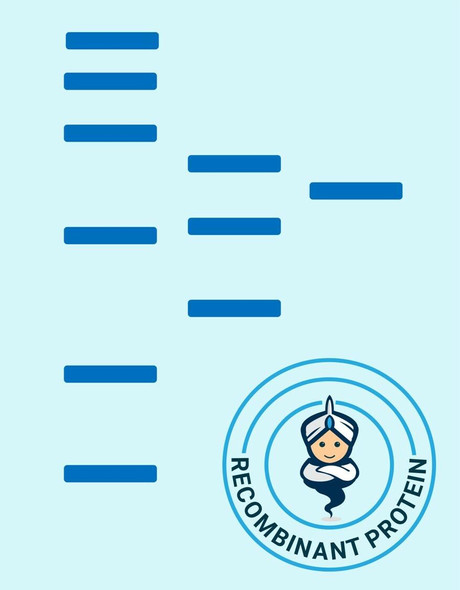Description
| Product Name: | Human BSND Recombinant Protein |
| Product Code: | RPPB2912 |
| Size: | 10µg |
| Species: | Human |
| Target: | BSND |
| Synonyms: | Bartter Syndrome Infantile With Sensorineural Deafness (Barttin) , Deafness Autosomal Recessive 73, DFNB73, BART, barttin. |
| Source: | Escherichia Coli |
| Physical Appearance: | Sterile Filtered clear solution. |
| Formulation: | The BSND solution (0.25mg/ml) contains 20mM Tris-HCl buffer (pH 8.0), 0.15M NaCl, 1mM DTT and 10% glycerol. |
| Stability: | Store at 4°C if entire vial will be used within 2-4 weeks. Store, frozen at -20°C for longer periods of time. For long term storage it is recommended to add a carrier protein (0.1% HSA or BSA).Avoid multiple freeze-thaw cycles. |
| Purity: | Greater than 90% as determined by SDS-PAGE. |
| Amino Acid Sequence: | MGSSHHHHHH SSGLVPRGSH MGSCQCYPKI TFVPADSDFQ GILSPKAMGL LENGLAAEMK SPSPQPPYVR LWEEAAYDQS LPDFSHIQMK VMSYSEDHRS LLAPEMGQPK LGTSDGGEGG PGDVQAWMEA AVVIHKGSDE SEGERRLTQS WPGPLACPQG PAPLASFQDD LDMDSSEGSS PNASPHDREE ACSPQQEPQG CRCPLDRFQD FALIDAPTLE DEPQEGQQWE IALPNNWQRY PRTKVEEKEA SDTGGEEPEK EEEDLYYGLP DGAGDLLPDK ELGFEPDTQG |
BSND is a vital beta subunit for CLC chloride channels. These heteromeric channels are restricted to basolateral membranes of renal tubules and of potassium-secreting epithelia of the inner ear. BSND gene mutations are linked with Bartter syndrome with sensorineural deafness.
BSND Human Recombinant produced in E.coli is a single, non-glycosylated polypeptide chain containing 290 amino acids (54-320) and having a molecular mass of 31.7kDa.BSND is fused to a 23 amino acid His-tag at N-terminus & purified by proprietary chromatographic techniques.
| UniProt Protein Function: | BSND: Functions as a beta-subunit for CLCNKA and CLCNKB chloride channels. In the kidney CLCNK/BSND heteromers mediate chloride reabsorption by facilitating its basolateral efflux. In the stria, CLCNK/BSND channels drive potassium secretion by recycling chloride for the basolateral SLC12A2 cotransporter. Defects in BSND are the cause of Bartter syndrome type 4A (BS4A); also known as infantile Bartter syndrome with sensorineural deafness. BS refers to a group of autosomal recessive disorders characterized by impaired salt reabsorption in the thick ascending loop of Henle with pronounced salt wasting, hypokalemic metabolic alkalosis, and varying degrees of hypercalciuria. BS4A is associated with sensorineural deafness. |
| UniProt Protein Details: | Protein type:Membrane protein, multi-pass; Membrane protein, integral; Transporter; Transporter, ion channel Chromosomal Location of Human Ortholog: 1p32.1 Cellular Component: basolateral plasma membrane; integral to plasma membrane; plasma membrane; protein complex Molecular Function:chloride channel activity; voltage-gated chloride channel activity Disease: Bartter Syndrome, Type 4a |
| NCBI Summary: | This gene encodes an essential beta subunit for CLC chloride channels. These heteromeric channels localize to basolateral membranes of renal tubules and of potassium-secreting epithelia of the inner ear. Mutations in this gene have been associated with Bartter syndrome with sensorineural deafness. [provided by RefSeq, Jul 2008] |
| UniProt Code: | Q8WZ55 |
| NCBI GenInfo Identifier: | 54035724 |
| NCBI Gene ID: | 7809 |
| NCBI Accession: | Q8WZ55.1 |
| UniProt Secondary Accession: | Q8WZ55,Q6NT28, |
| UniProt Related Accession: | Q8WZ55 |
| Molecular Weight: | 35,197 Da |
| NCBI Full Name: | Barttin |
| NCBI Synonym Full Names: | barttin CLCNK type accessory beta subunit |
| NCBI Official Symbol: | BSND�� |
| NCBI Official Synonym Symbols: | BART; DFNB73�� |
| NCBI Protein Information: | barttin |
| UniProt Protein Name: | Barttin |
| Protein Family: | Barttin |
| UniProt Gene Name: | BSND�� |
| UniProt Entry Name: | BSND_HUMAN |






